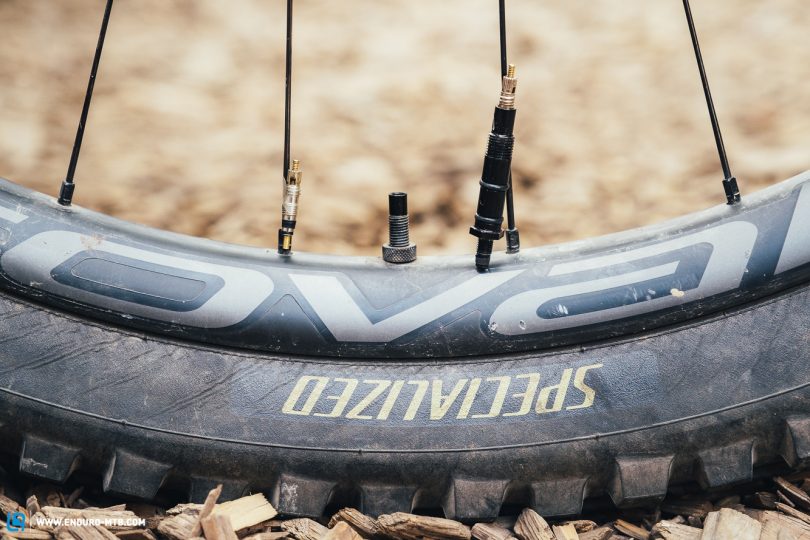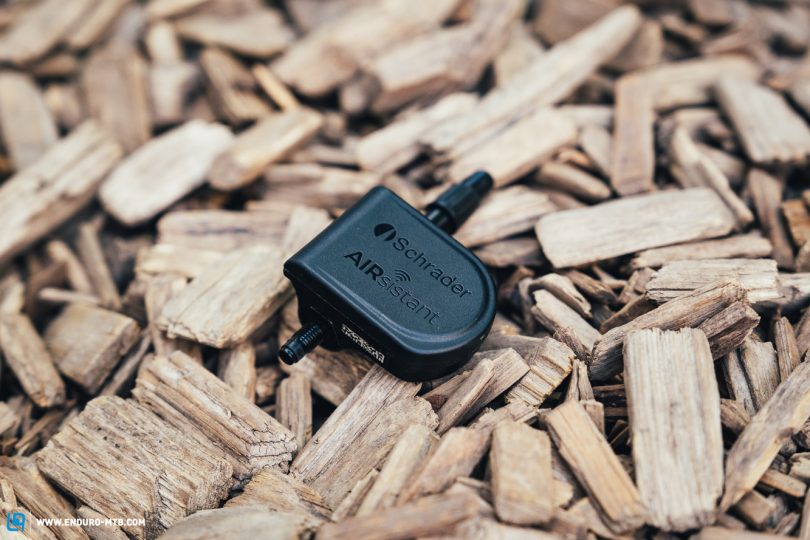Schrader AIRsistant
With AIRsistant, guessing the tire pressure using your thumb and index finger should be a thing of the past. Schrader’s digital tire pressure monitoring system is designed for retrofitting and allows you to check the pressure directly on your smartphone. We found out whether the system works and what it’s actually capable of!

More than 130 years ago, August Schrader developed a valve for pneumatic tires that’s long become standard in the automotive sector. With their new AIRsistant digital tire pressure control system, Schrader’s descendants are now determined to revolutionise the bicycle world with a clever new valve. Not only is AIRsistant meant to give you peace of mind by letting you know exactly how much pressure you’re running in your tires, but also to increase safety and improve handling by allowing you to run the right tire pressure. Positive side effects: slow punctures are a thing of the past and you don’t have to worry about damaging your rims and tires. Moreover, AIRsistant should help improve battery life and thus the range of your eMTB by allowing you to always run your tires at the ideal pressure.
The system uses a proprietary valve with integrated sensors to perform real time pressure readings. The sensors measure both the pressure and temperature of the tire. While temperature alone only plays a subordinate role in the riding behavior of a bike, at least you’ll be able to check the temperature in your garage. The valves can be purchased individually or as a set and are available both in the Schrader and Presta standards. Retail price is € 99.99 and weight is 20g per wheel for the valve and sensor. The two valve variants make it an interesting option not only for mountain bikers but also for city commuters. Unfortunately, you won’t be able to use AIRsistant on your car, because the system isn’t approved for this use and requires you to remove all the air for installation, so you couldn’t just quickly clip it on to check your pressures before a long journey. Readings can be taken directly via the AIRsistant app or a Garmin bike computer with Bluetooth connection, either in BAR or PSI. It’s also possible to recall the sensor data from an eBike display, albeit only in conjunction with the FIT system for the time being. Alongside the basic tire pressure and temperature functions, the app also features a pressure calculator and route planner.

The AIRsistant valves are easy and quick to install. Simply remove the valve core from the valve stem and replace it with the AIRsistant valve – a core remover is included in the package. To install the system, we recommend removing the retaining bolt that secures the sensor and then remove the sensor itself. Once that’s done, install the sensor and secure it with the retaining bolt. If you don’t remove the sensor from the valve during installation, this might get jammed against the spokes when tightening the valve, especially when you install it on wheels with more than 30 spokes. The system is compatible both with tubeless and inner tube systems, provided you can remove the valve core.

Now the sensors should be visible in the app. However, to access your data you’ll have to set up an account on the app and create a profile with personal data such as your weight, bike and intended use. The sensors can be added using either a QR code or the serial number. Since the QR code on the sensors is very small, we had to add the serial number manually. Once that’s sorted, the app displays the tire pressure and temperature on the sensor. The app is easy and intuitive to use and doesn’t require a PhD in quantum physics. To activate the sensors, you have to rotate the wheel by a quarter of a turn. The system will go automatically in standby mode when the wheels stop spinning for more than 120 seconds. This technology is already in use in the automotive sector, where it has proven to have great longevity. The batteries of the sensor can neither be replaced nor charged. However, according to the manufacturer, this shouldn’t be a problem, because they last around 5000 riding hours, which translates into 5 years of service life for most riders. The pressure calculator allows you to work out the optimal tire pressure based on the following factors: bike type (trekking, city, MTB, road), ebike (yes, no) tubeless tires (yes, no), tire size and width as well as rider weight. If you fall below or exceed the recommended pressure, the system warns you with a message on your mobile phone. But be careful! In our opinion, the recommended pressures are too low! With our test mountain bike with tubeless tires and a 75 kg rider, the pressure calculator recommended 1.5 BAR at the front and 1.55 BAR at the rear. If we had followed this recommendation, we would have ended up damaging the rims and regretting our choice for the rest of the week. However, experienced and careful riders might get away with the recommended air pressure. If you already know your optimal tire pressure, you can save this in the app and receive a warning whenever you drop below it, regardless of what the pressure calculator suggests. AIRsistant comes in handy if your pump gauge isn’t accurate and/or if you don’t want to carry around a conventional air pressure gauge.

If you want to check your tires quickly and easily before every ride, this is a great little gadget and even if you aren’t too fussed about always running the optimal air pressure, AIRsistant helps you keep safe just by sending you a simple reminder to keep your tires topped up.
Tops
- easy to install and use
- good connectivity
- air pressure gauges allow you to ride without carrying a separate gauge and work accurately
Flops
- pressures recommended by the calculator are rather low
- rather expensive
- stops working when the battery is empty
For more information visit airsistant.com.
Did you enjoy this article? If so, we would be stoked if you decide to support us with a monthly contribution. By becoming a supporter of ENDURO, you will help secure a sustainable future for high-quality mountain bike journalism. Click here to learn more.
Words: Felix Rauch Photos: Mike Hunger








